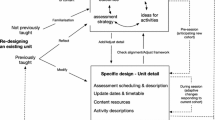Abstract
This article describes the roles instructional designers are likely to be playing in public schools and higher education in the year 2001. Also put forth is a prediction regarding teacher use of instructional design principles.
Similar content being viewed by others
References
Carrier, C. A. (1986). A first meeting of professors of educational technology: A summary of issues.Journal of Instructional Development, 8(3), 15–19.
Dick, W., Berquist, C. C., & Vedros, R. G. (1987). A training program for instructional materials selection.Educational Technology, 27(6), 32–34.
Dick, W., & Reiser, R. A. (in press).Planning effective instruction. Englewood Cliffs, NJ: Prentice-Hall.
Gagne, R. M., & Driscoll, M. P. (1988).Essentials of learning for instruction (2nd ed.). Englewood Cliffs, NJ: Prentice-Hall.
Good, T. L., & Brophy, J. E. (1986).Educational psychology (3rd ed.). New York: Longman.
Gustafson, K., & Bratton, B. (1984). Instructional improvement centers in higher education: A status report.Journal of Instructional Development, 7(2), 2–7.
National Commission on Excellence in Education. (1983).A nation at risk: The imperative for educational reform. Washington, DC: United States Department of Education.
National Task Force on Educational Technology. (1986). Transforming American education: Reducing the risk to the nation.Techtrends, 31(4), 10–23, 35.
Redfield, D. D., & Dick, W. (1984). An alumni-practitioner review of doctoral level competencies in instructional systems.Journal of Instructional Development, 7(1), 10–13.
Reiser, R. A. (1986). Some questions facing programs in instructional technology and some means for answering them.Journal of Instructional Development, 8(3), 20–23.
Rossett, A., & Garbosky, J. (1987). The use, misuse, and non-use of educational technologists in public education.Educational Technology, 27(9), 37–42.
Salisbury, D. F., (Ed.). (1987). Instructional design and the public schools [Special issue].Journal of Instructional Development, 10(4).
Schiffman, S., & Gansneder, B. (1987). Graduate programs in instructional technology: Their characteristics and involvement in public education.Journal of Instructional Development, 10(3), 22–28.
Sullivan, H., & Higgins, N. (1983).Teaching for competence. New York: Teachers College Press.
Woolfolk, A. E. (1987).Educational psychology (3rd ed.). Englewood Cliffs, NJ: Prentice-Hall.
Author information
Authors and Affiliations
Rights and permissions
About this article
Cite this article
Reiser, R.A. Instructional designers in public schools and higher education: Predictions for the year 2001. Journal of Instructional Development 11, 3–6 (1988). https://doi.org/10.1007/BF02905791
Issue Date:
DOI: https://doi.org/10.1007/BF02905791




